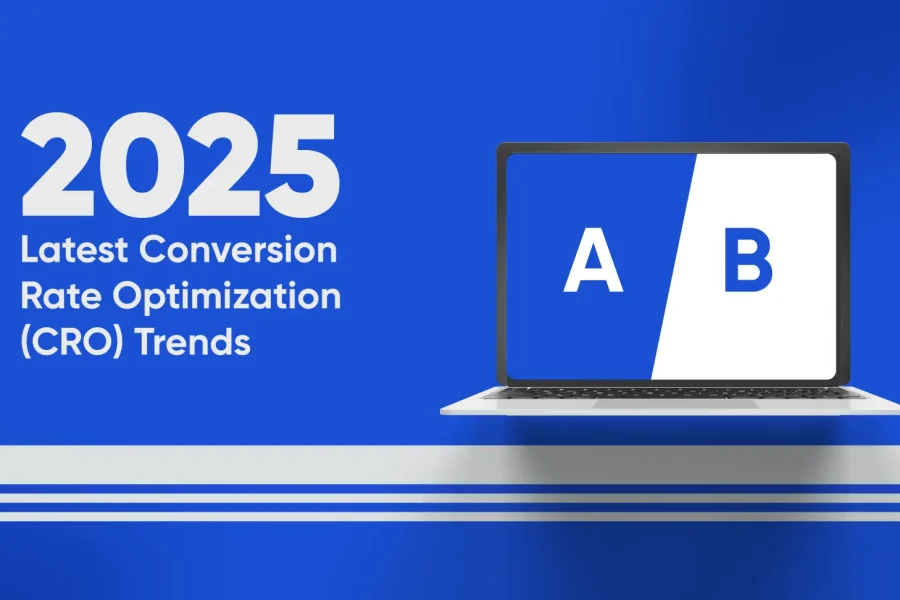Conversion Rate Optimization (CRO) in 2025 is no longer just about tweaking buttons or headlines!
It’s about creating smart, personalized experiences that truly connect with users.
Do You Know:
Almost 60% of B2B marketers say CRO is the most useful metric for landing page performance
70% of marketers who engage in CRO work use the outcome of their experiments to inform other marketing decisions
As digital landscapes shift and customer expectations rise, businesses must rethink how they engage, convert and retain.
This rich article from Tatvic breaks down the latest CRO trends that are set to redefine landing page experience in 2025 and beyond.
CRO’s Role in 2025 & Beyond
We’re entering an era where personalization and relevance aren’t optional, they’re expected.
Conversion Rate Optimization (CRO) in 2025 is becoming more predictive, contextual, and privacy-first.
Businesses that fail to adopt emerging technologies will struggle to keep up with users’ dynamic needs.
To stay competitive, brands must prioritize data-driven experimentation and user-centric design across every touchpoint.
Modern Conversion Rate Optimization (CRO) isn’t just about conversions, it’s about building trust, loyalty, and seamless digital experiences.
Why Traditional CRO Isn’t Enough Anymore
Gone are the days when changing a button color or tweaking a headline was enough to move the needle.
In today’s landscape, users expect frictionless journeys, real-time relevance, and tailored interactions.
Conversion Rate Optimization (CRO) has evolved into a dynamic blend of psychology, data and technology.
Simple A/B testing in CRO just doesn’t cut it anymore.
Remember when split testing a CTA color felt groundbreaking?
In 2025, such tactics barely scratch the surface.
Today’s users demand instant, personalized, secure experiences and CRO has to deliver just that, powered by AI and first-party data rather than guesswork.
Today’s CRO strategies require a deeper understanding of user behavior across multiple devices and platforms.
Generic landing pages no longer engage—users expect dynamic content that adapts to their intent in real time.
With the decline of third-party cookies, Conversion Rate Optimization (CRO) must now rely on ethical data collection and transparent user experiences.
Modern CRO integrates emotional triggers and UX psychology to guide decision-making, not just design tweaks.
Success now hinges on continuous optimization, driven by real-time insights, not static, one-off experiments.
Top & Latest Conversion Rate Optimization (CRO) Trends You Can’t Ignore
Staying ahead in 2025 means embracing Conversion Rate Optimization (CRO) trends that put user experience at the center.
From AI-driven personalization to frictionless mobile journeys, the future of CRO is smarter and faster.
Today’s top-performing brands are using real-time data to tailor every touchpoint with precision.
If you’re not optimizing for intent, context and speed then you’re already falling behind.
Let’s See Top & Latest Conversion Rate Optimization (CRO) Trends in 2025 & Beyond
1. Agentic AI for Smarter Personalization:
Agentic AI represents the next leap in digital personalization.
Unlike traditional rule-based automation, Agentic AI understands user intent, behavior and context in real time.
Real-World Example: Amazon’s homepage uses machine learning and Agentic systems to show different product recommendations to different users—even for the same keyword search—based on time of day, previous interactions, and device used.
Best Practices:
- Integrate Agentic AI with your CRM and analytics stack.
- Continuously test and train your AI models with updated data.
- Use dynamic content blocks that adapt to user behavior in real-time.
2. Predictive Behavior Tracking:
Modern Conversion Rate Optimization (CRO) goes beyond observing what users do.
It anticipates what they’re about to do. Using predictive analytics, platforms can identify behaviors like exit intent, hesitation, or frequent cart abandonment.
Real-World Example: Netflix uses predictive analytics to suggest content right when users are likely to stop watching or get bored—keeping engagement high.
Best Practices:
- Analyze heatmaps and session recordings to detect friction points.
- Use machine learning to trigger context-aware nudges.
- Continuously A/B test predictive interventions to refine accuracy.
3. Real-Time Website Adaptability:
Users now expect websites to be as responsive as conversations. Real-time orchestration adjusts your site based on visitor data changing banners for rainy weather, surfacing local offers, or adjusting tone for time-of-day browsing.
Real-World Example: Starbucks updates its mobile app offers and featured items based on local weather and user location.
Best Practices:
- Integrate third-party data sources (weather, geolocation, etc.).
- Use behavioral segments to determine real-time user intent.
- Test adaptive elements frequently to ensure seamless transitions.
4. Conversions Straight from SERPs:
Zero-click conversions are on the rise.
Whether it’s booking a service, calling a business or reading an FAQ; all from Google’s search result page.
Brands must optimize their content for immediate engagement.
Real-World Example: Domino’s Pizza optimized its Google Business Profile with updated menus and “Call Now” CTAs, leading to a direct increase in orders without site visits.
Best Practices:
- Create and structure content with schema markup (FAQ, How-to, Local Business, etc.).
- Keep Google My Business profiles updated and enriched.
- Target long-tail, intent-driven queries that trigger featured snippets.
5. Emotion-Led Design (Neurodesign):
CRO isn’t just about usability, it’s about emotional resonance.
Neurodesign applies behavioral psychology to UX.
Thoughtfully chosen color palettes, micro-interactions, and intuitive flows can reduce decision fatigue and create positive emotional anchors.
Real-World Example: Airbnb uses calming visuals, conversational UI, and minimal clutter to make booking feel personal and stress-free.
Best Practices:
- Conduct user research to identify emotional triggers.
- Leverage psychological design principles like the F-pattern or Hick’s Law.
- Incorporate feedback loops through visual cues and animations.
6. Cookieless CRO with First-Party Data:
With the demise of third-party cookies, CRO needs to lean on data users willingly provide.
Tactics like interactive content (e.g., quizzes), account creation benefits, and email interactions enable brands to build robust first-party data ecosystems.
Real-World Example: Sephora uses quizzes to learn about customer preferences and recommend personalized products, all without relying on cookies.
Best Practices:
- Use progressive profiling to collect data over time.
- Offer value in exchange for user data (e.g., personalized guides, loyalty points).
- Ensure transparency with users on how their data is used.
7. Cross-Device Experience Optimization:
In 2025, users are moving across devices like never before. CRO must ensure that the transition from desktop to mobile to wearable is smooth and consistent.
Real-World Example: Booking.com lets users save hotel listings on desktop and access them instantly via mobile app or email link.
Best Practices:
- Use responsive and adaptive design patterns.
- Implement cloud-based session storage for cross-device continuity.
- Test all CRO elements across different device combinations.
8. Voice & Visual Search Readiness:
With devices like Alexa, Google Lens, and smartphones, users now search by voice and image. CRO must evolve to accommodate these non-text-based interactions.
Real-World Example: IKEA’s app allows users to snap a photo of a space and receive furniture recommendations that fit the visual context.
Best Practices:
- Use conversational keywords and schema for voice search.
- Optimize image alt text, titles, and metadata for visual discovery.
- Include AR/VR experiences where relevant (e.g., virtual try-ons).
9. Smarter, Faster Checkout Experiences:
A lengthy checkout is a conversion killer.
Simplified checkout processes that include features like one-tap payments, guest checkout, and autofill make the final step frictionless.
Real-World Example: Amazon’s one-click checkout streamlines the purchase process, increasing the likelihood of impulse buys and repeat purchases.
Best Practices:
- Reduce the number of form fields (ideally 6 or fewer).
- Add trust signals, security icons, testimonials and guarantees.
- Provide multiple payment options, including BNPL (Buy Now Pay Later) and UPI.
10. Appealing to Eco-Conscious Buyers:
Sustainability influences conversion.
Whether it’s carbon-neutral shipping or eco-friendly packaging, users want their purchases to reflect their values.
Real-World Example: Patagonia includes detailed sustainability practices on every product page, helping customers make values-driven decisions.
Best Practices:
- Add environmental impact badges or labels.
- Include sustainability messaging in the checkout flow.
- Highlight eco-practices in product descriptions and emails.
By following these these Latest Conversion Rate Optimization (CRO) Trends businesses can win in the CRO game and generate visible impacts
How Tatvic Future-Proofs Your CRO Strategy
Tatvic future proofs CRO strategy by following the latest CRO Trends which drive visible results.
It help brands stay ahead by combining Agentic AI, deep analytics, and intuitive UX.
From real-time personalization tools to privacy-first data strategies, we build CRO systems that evolve with your users not against them.
We don’t just analyze what users click, we uncover why they act, and what will make them convert.
Tatvic’s unique blend of behavioral science and agentic AI ensures your CRO approach is not only data-driven but deeply human-centric.
Whether it’s optimizing micro-moments on mobile or building trust on checkout pages, our strategies are tailored to real-world user journeys.
Tatvic stays ahead of algorithm shifts and privacy standards, keeping your brand visible and compliant.
From zero-click search readiness to first-party data enablement, we future-proof every stage of your conversion funnel.
Our team doesn’t believe in one-size-fits-all; we design CRO frameworks that evolve with your audience and industry.
Final Thoughts: Ready for the CRO Revolution?
CRO in 2025 is fast, flexible, and deeply human-centric.
It’s about creating journeys that feel tailor-made, driven by ethical data use and empathetic design.
It’s no longer about tweaking, it’s about transforming how users engage with your brand at every digital touchpoint.
With customer expectations constantly rising, your CRO strategy must be agile, ethical, and insight-led.
Tatvic empowers you to adapt in real-time, leveraging smart automation and design that speaks to user intent.
As search behaviors evolve, our CRO frameworks ensure your brand remains discoverable and conversion-ready.
By future-proofing your funnel today, you stay relevant, competitive, and loved by your customers tomorrow.



